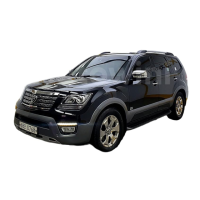
Do you have a question about the Kia Borrego 2017 and is the answer not in the manual?
| Brand | Kia |
|---|---|
| Model | Borrego 2017 |
| Category | Automobile |
| Language | English |
Explains manual layout, sections, index, and use of warnings and cautions.
Details recommended gasoline and fuel types, octane ratings, and warnings on methanol fuels.
Covers safe operation, design characteristics affecting handling, and rollover risk.
Provides an overview of the vehicle's exterior features with labeled diagrams.
Provides an overview of the vehicle's interior features with labeled diagrams.
Provides an overview of the instrument panel features with labeled diagrams.
Covers front, 2nd, and 3rd-row seat adjustments, headrests, and seatback pockets.
Details seat belt restraint systems, pre-tensioners, precautions, and care.
Explains using child restraint systems, installation, and precautions.
Discusses air bag operation, warning lights, components, types, care, and precautions.
Covers key identification, operations, and the immobilizer system.
Explains smart key operations, functions, precautions, and remote keyless entry.
Explains operating door locks from inside and outside, auto lock/unlock features, and child-protector lock.
Explains power windows, auto up/down, and the window lock switch.
Covers power steering, tilt steering, heated steering wheel, and horn operation.
Explains the instrument cluster layout, including gauges, LCD display, and warning lights.
Explains operation of headlights, parking lights, auto lights, fog lights, and turn signals.
Covers front windshield wipers/washers, auto control, and rear window wipers/washers.
Details features of the audio system with touch screen, including radio, media, phone, and Bluetooth® modes.
Explains making calls, phone menus, contacts download, and Bluetooth® settings.
Details pairing, connecting, and managing Bluetooth® devices for Type-1 systems.
Covers pre-drive checks including windows, tires, leaks, obstacles, and cabin checks.
Explains ignition switch positions (LOCK, ACC, ON, START) and illuminated switch features.
Details illuminated button, positions (OFF, ACC, ON, START/RUN), and anti-theft steering lock.
Explains automatic transaxle operation, ranges (P, R, N, D), manual mode, and shift lock system.
Explains 4WD modes (2H, 4H, 4L), cautions, and knob operation.
Covers power brakes, parking brake, disc brakes, and ABS/ESC warnings.
Covers system function, warnings, operation, setting speed, and cancelling cruise control.
Explains LDWS operation, warnings, indicator lights, and non-operation conditions.
Explains BSD, LCA, RCTA functions, operating conditions, warnings, and detecting sensors.
Provides driving suggestions to save fuel and reduce maintenance costs.
Covers hazardous driving, rocking the vehicle, smooth cornering, and driving at night/in rain/flooded areas/off-road.
Provides suggestions for driving in snowy, icy, or cold conditions, including tire and chain recommendations.
Explains the use and operation of hazard warning flashers.
Provides guidance for engine stalls, flat tires, and general emergency driving situations.
Covers troubleshooting steps when the engine doesn't turn over or fails to start.
Details procedures for jump-starting a vehicle with a discharged battery.
Steps to take if the engine overheats, including checking coolant and drive belts.
Explains checking tire pressure, low tire pressure telltales, and TPMS malfunction indicators.
Covers using the jack and tools, removing/storing the spare tire, and changing tires.
Shows labeled diagrams of the engine compartment for gasoline and diesel engines.
Emphasizes owner's responsibility for maintenance and recommends authorized dealer service.
Lists owner maintenance checks and schedule for performing them.
Outlines normal and severe usage maintenance schedules.
Details wiper blade inspection and replacement procedures.
Provides information on battery service, recharging, and safety precautions.
Covers tire care, inflation pressures, rotation, alignment, replacement, and safety.
Provides detailed vehicle dimensions including length, width, height, tread, and wheelbase.
Lists engine specifications such as displacement, bore, stroke, firing order, and number of cylinders.
Details GVW for gasoline and diesel engines, and for different regions.
Lists refrigerant weight and classification, and compressor lubricant type.
Details the wattage for various exterior and interior light bulbs.
Covers tire care, inflation pressures, rotation, alignment, replacement, and safety.
Provides a chart for recommended engine oil viscosity based on ambient temperature.
Explains where to find the VIN on the vehicle.
